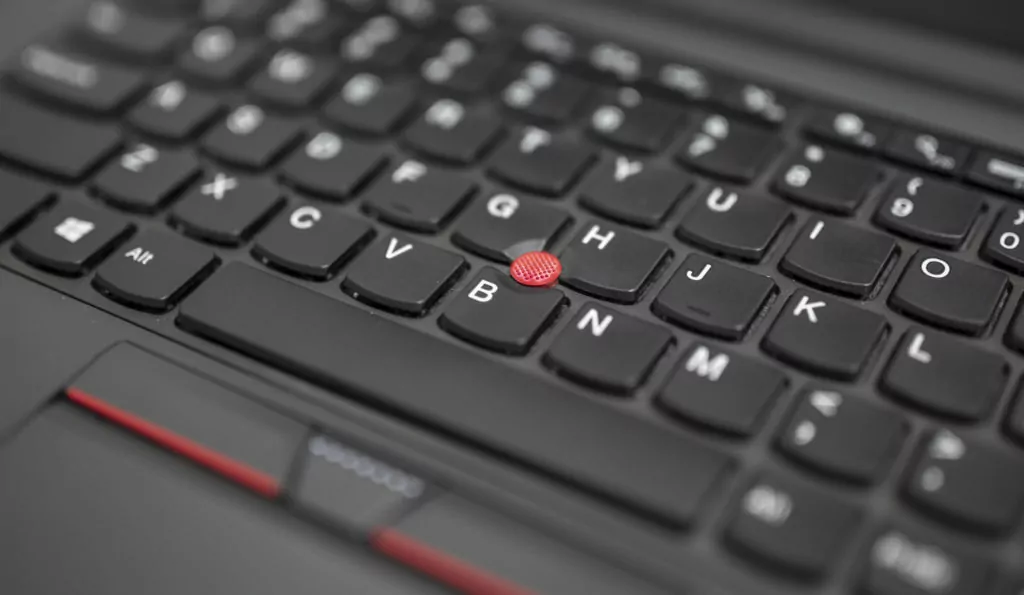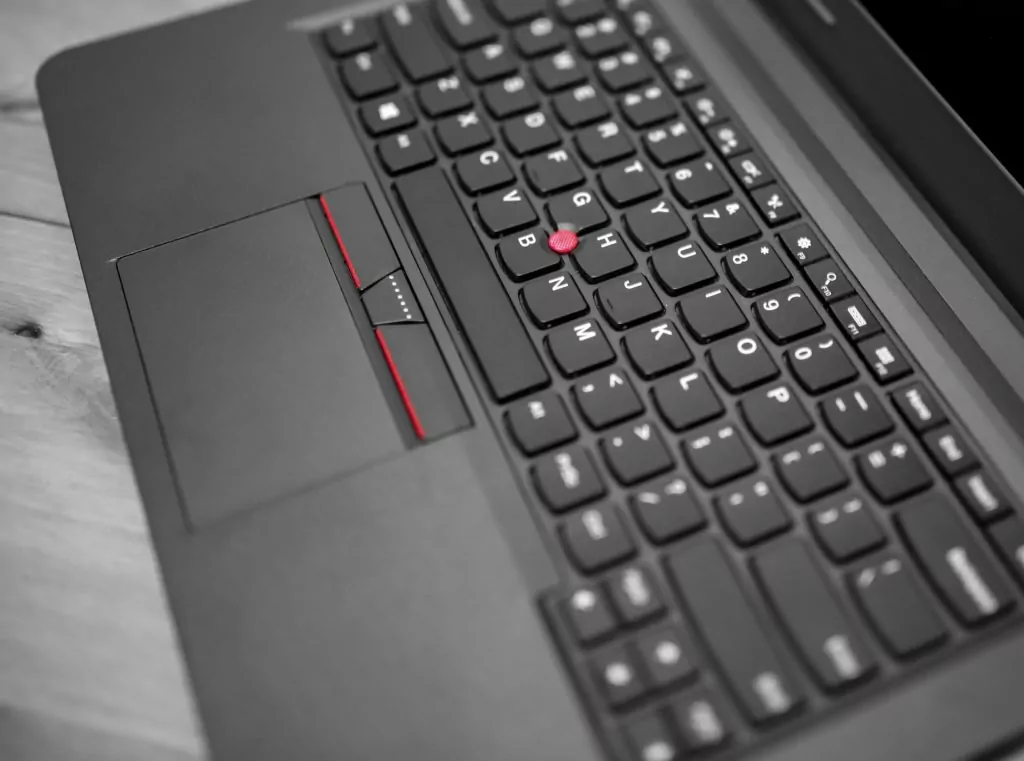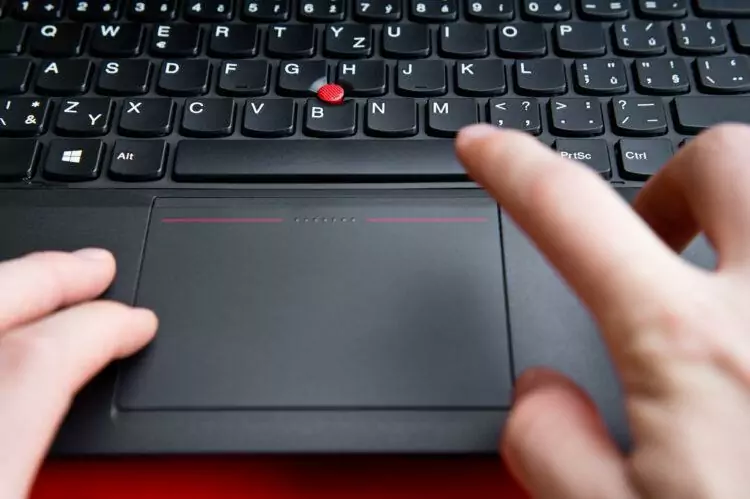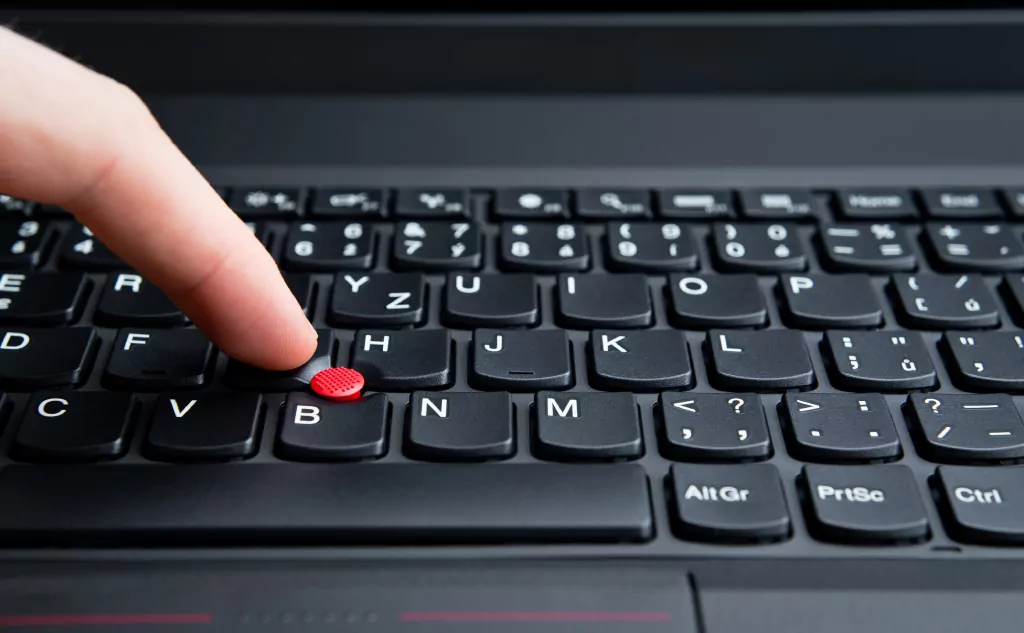Here’s what the small Thinkpad red button in the middle of a laptop keyboard is for:
The small red button is a mouse controller that is commonly used on laptops to save space on the keyboard part of the layout. This is most commonly seen on Lenovo Thinkpad keyboards, with the middle button used to function as a mouse.
Formally called a TrackPoint, this device allows you to fully control a mouse without the need for a trackpad.
It was more popular in the past, but new laptops still utilize the feature.
So if you want to learn all about this small red button on laptop keyboards, then you’re in the right place.
Let’s get started!
Why Is There a Small Red Button in the Middle of the Laptop Keyboard?

The Thinkpad red button goes by a few names.
It is known as a pointing stick, TrackPoint, or nub.
There are other colloquial names, but those are the main names.
The Lenovo Thinkpad middle button is designed to function as a mouse on the laptop.
The concept is simple, and it was fairly popular on laptops for a long time.
Today, you see fewer TrackPoints than ever, but they do still exist.
We’ll get into the modern versions later.
For now, let’s cover the basics.
The nub is a lot like a joystick.
You can push it in different directions, and the cursor on your screen will respond accordingly.
Some people prefer this method of control as compared to a trackpad, but plenty of others disagree.
The nub is intended to be fairly responsive to the pressure you apply to it.
That means that (at least in theory) you can push it gently to barely move the mouse.
Or, you can apply more pressure, and the mouse will move faster.
We can talk about how that actually works in a bit.
For the most part, controlling a pointing stick is much like any other mouse control.
It takes a little practice, but the overall execution is intuitive and easy to master with little practice.
Also, like other mouse interfaces, the Thinkpad red button or TrackPoint can be customized to give you the control features you prefer.
You can use properties to allow scrolling from the track point.
This causes it to scroll screens instead of controlling the mouse cursor, and this is a popular use for the device.
It adds total control to the laptop.
You can also set it to function as a zoom feature or a mouse button.
For laptops that have this device installed, you can find the custom control options in your software.
When you look at your computer settings, you want to look for mouse properties.
Under that option, you should see a listing for the TrackPoint.
That is where you can adjust how it functions.
You can also control sensitivity and other features.
Where Does the Small Thinkpad Red Button Come From?

The Thinkpad red button, also called TrackPoint was originally designed by IBM in the early 90s.
When laptops were still thick and heavy, engineers were trying to find ways to reduce cumbersome design elements.
Having to carry a mouse around with the laptop was annoying, but building a mouse into the device made it heavier and more complicated.
IBM’s answer to that conundrum was the TrackPoint.
It was deputed in the 90s, and they formally patented the TrackPoint in the late 90s after the patent is when the feature became a lot more prominent.
The Evolution of The TrackPoint
Originally, the pointing stick was only found on IBM computers, but new computer manufacturers were popping up all over the place, and many of them contracted with IBM to use various designs owned by the company.
By the early 2000s, you could find the nub mouse controllers on all kinds of laptops, including those made by HP, Toshiba, Sony, Samsung, Gateway, and many more.
As more computer companies emerged, many of them adopted the pointing stick.
Even today, Lenovo has Thinkpad models that include this little red button.
As touch technology improved, a lot of designers started moving away from the pointing stick.
Trackpads became easier to use and lighter to produce.
They took over as a standard method of building mouse control into a laptop, and it is very likely that you are already familiar with touchpads on laptops.
It was around 2007 that the competition between TrackPoints and trackpads hit its climax.
People even published research papers debating which was better.
From that moment on, TrackPoints were in decline and trackpads have been seen everywhere.
In 2014, Lenovo redesigned the TrackPoint, and since then, it has scarcely been seen on laptops made by anyone other than Lenovo.
How Does the TrackPoint Work?

Originally, the TrackPoint was an analog controller.
It worked the same way as a joystick or any number of other devices in that vein.
When you press on the nub, pressure sensors indicate how far the centerpiece has been pushed in a given direction.
The severity of that pressure is translated into an electric signal that the computer interprets.
The result is translated into the mouse movement that you see.
Early TrackPoints were covered by a rubber topper that had a consistency much like an eraser.
It was gentle and had strong tactile responses, making it easier to control.
As time went on, the caps for the TrackPoint evolved.
The Thinkpad red button and similar versions are pointing sticks usually covered with a plastic textured cap that allows it to stick nicely to your finger and improve control.
The way TrackPoints work has also been updated.
In 2014, Lenovo (now the owner of IBM) redesigned the TrackPoint and patented the new features.
They transitioned out of analog controls and created a digital control scheme for the TrackPoint.
This ultimately means that the new version has more precise control.
It also works better with software controllers, giving you more options and settings than ever before.
How The Trackpoint Functions as a Mouse Explained
The digital input allows the TrackPoint to better leverage a design feature known as “negative inertia.”
In physics, inertia is the natural resistance to change in an object.
If you try to pull a full refrigerator out of its cubby to do some sweeping, it’s hard to get it to budge.
Once it does budge, things seem to go a little easier. That’s the concept of inertia.
The digital negative inertia has the opposite effect when you use the TrackPoint to control your mouse cursor.
The cursor moves fastest and easiest when you first apply an input, and then it becomes more resistant to change after it starts moving.
This makes it easy to quickly move the cursor across the screen.
When it gets closer to your target, it slows down and responds a little more sluggishly, making it easier to land the cursor precisely as intended.
Many other digital features work behind the scenes to make modern TrackPoints easier to use than ever.
Despite the changes, Lenovo has shown that they are devoted to preserving the integrity of the experience.
The first attempts to change the TrackPoint were met with criticism from fans.
Lenovo reverted those changes and has not returned to them.
Is This Small Red Button Still in New Laptops?

We’ve gone deep into how pointing sticks work, what they do and why they are around.
What can you expect from them today?
Considering the technological upgrades, you might think that they are more popular.
Really, they serve more of a niche role in modern computer peripherals.
For starters, pointing sticks are exceedingly rare on laptops that are not made by Lenovo.
Part of that stems from the declining popularity of the device.
Part of it stems from Lenovo wanting to corner the niche market of TrackPoint lovers.
Regardless of the reasoning, TrackPoints are most common on the Lenovo Thinkpad as the middle button intended to function as a mouse. This is uncommon elsewhere.
Keyboard Add-Ons with The Red Button Option
But, there’s a whole different iteration of pointing sticks that isn’t necessarily attached to laptops.
There are extended peripherals that add the nub to computer add-ons.
The easiest to understand is external keyboards.
People who love the pointing stick can get a Lenovo keyboard to plug into a desktop PC (or any PC for that matter).
The keyboard has the nub in the middle and mouse buttons on the bottom.
It makes the experience virtually identical to what you would expect from a Thinkpad laptop.
Other extended peripherals can also add the TrackPoint nub.
People who prefer it customize it to run operations the way they like and will swear by the performance of the TrackPoint. Learn more about the history and function of TrackPoint here.
Because of these add-ons, you might occasionally see these devices on workstations and computers where you least expect them.
For now, you can expect TrackPoints to stick around for many more years.
They will only fully disappear when the niche crowd stops demanding them.
Does the TrackPoint Button Add Value to a Computer?

The short answer is no.
While there is a devoted niche crowd that loves pointing sticks, they don’t represent a market that can add value to a computer based on this simple device.
For starters, the majority of computers with this feature are beyond outdated.
They are obsolete, and very few people collect obsolete computers.
The second challenge comes in the fact that people who want a TrackPoint can still get it on a new computer.
Their options are limited.
With new laptops and add-ons that can supply this feature, there’s no reason to pay a premium for a computer simply because it has a nub mouse controller.
If you unearth an old computer that has this little feature, you have simply found an old computer.
If you’d like to learn more about the parts and functions of keyboards, explore our in-depth article here.


